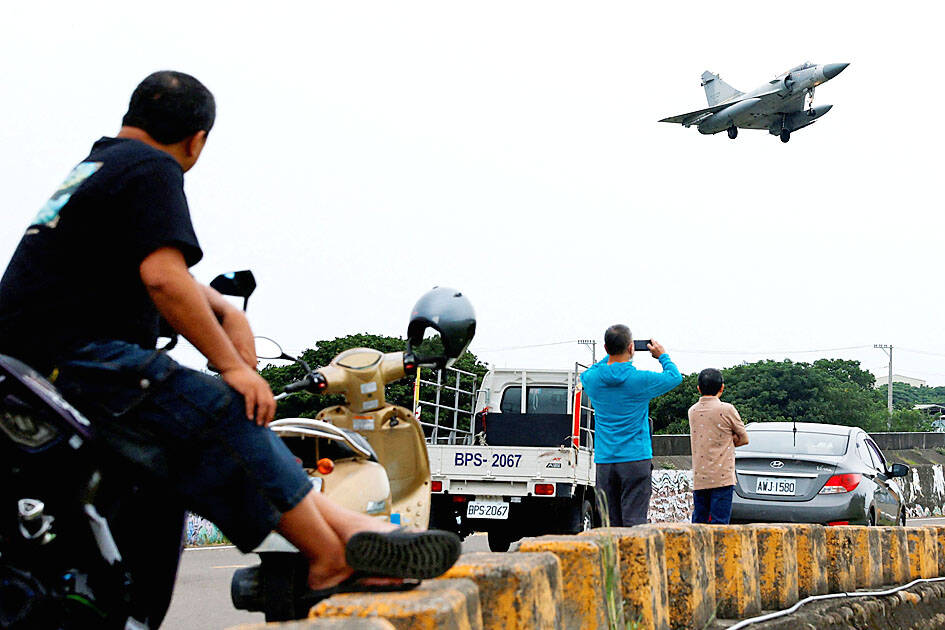Officials from the US, Japan and other nations yesterday called for peace in the Taiwan Strait, as Beijing initiated two days of military exercises around Taiwan days after President William Lai (賴清德) took office.
China’s military drills were expected, but “concerning,” US Marine Corps Lieutenant General Stephen Sklenka told an audience in Canberra.
“We expected something like this, frankly,” the US Indo-Pacific Command deputy commander said.

Photo: Carlos Garcia Rawlins, Reuters
“Just because we expect that behavior does not mean that we should not condemn it, and we need to condemn it publicly,” he said. “It is concerning.”
Other nations should speak out against the drills, Sklenka said.
“It’s one thing when the United States condemns the Chinese, but there’s a far more powerful effect, I believe, when it comes from nations within this region,” he told reporters. “I also believe in my heart of hearts that conflict between our two nations is not inevitable, and it’s not a foregone conclusion.”
Sklenka said he believed the “target” of China’s exercises was its own domestic population, not the international community.
The exercises are part of a sustained pressure campaign against Taiwan stretching back to 2022, Sklenka said, adding that once-rare incursions into Taiwan’s air defense identification zone have become normal.
Meanwhile, Canberra is concerned that large-scale Chinese military operations in the Taiwan Strait risk causing an accident or escalating tensions, a spokesperson for Australian Minister for Foreign Affairs Penny Wong (黃英賢) said.
“The risk of an accident and potential escalation is growing,” the spokesperson said. “Peace and stability in the Taiwan Strait is in all of our interests.”
In Japan, Chief Cabinet Secretary Yoshimasa Hayashi called for dialogue.
“We hope for the issues over Taiwan to be resolved peacefully through dialogue; that has been our consistent position,” he said. “It is important to clearly communicate the importance of peace and stability in the Taiwan Strait directly to China, and work closely with allies including the United States and clearly communicate the shared position of each country.”
Japanese Minister of Foreign Affairs Yoko Kamikawa weighed in while visiting the US, saying Japan and Taiwan share values and principles, including freedom, democracy, basic rights and rule of law.
Taiwan “is our extremely important partner that we have close economic relations and exchanges of people, and is our precious friend,” she told reporters in Washington, where she held talks with US Secretary of State Antony Blinken.
She said they discussed Taiwan and the importance of peace in the Taiwan Strait.
The South Korean Ministry of Foreign Affairs said that peace and stability in the Taiwan Strait should be maintained when asked during a briefing about the drills.
Additional reporting by AP

STILL COMMITTED: The US opposes any forced change to the ‘status quo’ in the Strait, but also does not seek conflict, US Secretary of State Marco Rubio said US President Donald Trump’s administration released US$5.3 billion in previously frozen foreign aid, including US$870 million in security exemptions for programs in Taiwan, a list of exemptions reviewed by Reuters showed. Trump ordered a 90-day pause on foreign aid shortly after taking office on Jan. 20, halting funding for everything from programs that fight starvation and deadly diseases to providing shelters for millions of displaced people across the globe. US Secretary of State Marco Rubio, who has said that all foreign assistance must align with Trump’s “America First” priorities, issued waivers late last month on military aid to Israel and Egypt, the

France’s nuclear-powered aircraft carrier and accompanying warships were in the Philippines yesterday after holding combat drills with Philippine forces in the disputed South China Sea in a show of firepower that would likely antagonize China. The Charles de Gaulle on Friday docked at Subic Bay, a former US naval base northwest of Manila, for a break after more than two months of deployment in the Indo-Pacific region. The French carrier engaged with security allies for contingency readiness and to promote regional security, including with Philippine forces, navy ships and fighter jets. They held anti-submarine warfare drills and aerial combat training on Friday in

COMBAT READINESS: The military is reviewing weaponry, personnel resources, and mobilization and recovery forces to adjust defense strategies, the defense minister said The military has released a photograph of Minister of National Defense Wellington Koo (顧立雄) appearing to sit beside a US general during the annual Han Kuang military exercises on Friday last week in a historic first. In the photo, Koo, who was presiding over the drills with high-level officers, appears to be sitting next to US Marine Corps Major General Jay Bargeron, the director of strategic planning and policy of the US Indo-Pacific Command, although only Bargeron’s name tag is visible in the seat as “J5 Maj General.” It is the first time the military has released a photo of an active

CHANGE OF MIND: The Chinese crew at first showed a willingness to cooperate, but later regretted that when the ship arrived at the port and refused to enter Togolese Republic-registered Chinese freighter Hong Tai (宏泰號) and its crew have been detained on suspicion of deliberately damaging a submarine cable connecting Taiwan proper and Penghu County, the Coast Guard Administration said in a statement yesterday. The case would be subject to a “national security-level investigation” by the Tainan District Prosecutors’ Office, it added. The administration said that it had been monitoring the ship since 7:10pm on Saturday when it appeared to be loitering in waters about 6 nautical miles (11km) northwest of Tainan’s Chiang Chun Fishing Port, adding that the ship’s location was about 0.5 nautical miles north of the No.